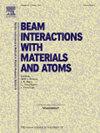电子辐照诱导ZnGeP2单晶光吸收的在线和原位研究
IF 1.4
3区 物理与天体物理
Q3 INSTRUMENTS & INSTRUMENTATION
Nuclear Instruments & Methods in Physics Research Section B-beam Interactions With Materials and Atoms
Pub Date : 2025-06-04
DOI:10.1016/j.nimb.2025.165758
引用次数: 0
摘要
本文研究了高能电子辐照下锌锗二磷化物、ZnGeP2 (ZGP)晶体和新型掺锡ZGP晶体的吸光度。在线和原位实验在720-1100 nm范围内进行。诱导吸光度的光谱由一条“尾巴”组成,最大值似乎位于低于所研究光谱范围的波长处。在电子束关闭后,一小部分诱导吸光度在一分钟内消失,表明存在亚稳效应。在800 nm处观察到低通量和高通量对诱导吸光度的贡献。第一个达到一个限值,似乎受到锡掺杂或缺乏生长后退火的影响,而高通量贡献在所研究的范围内不具有饱和度,也不取决于样品类型。本文章由计算机程序翻译,如有差异,请以英文原文为准。
Online and in situ investigation of electron irradiation induced optical absorption in ZnGeP2 single crystals
In the present study, the absorbance induced in Zinc germanium diphosphide, ZnGeP2 (ZGP) crystals and new Sn-doped ZGP crystals has been investigated under irradiation with high energy electrons. Online and in situ experiments were performed in the range 720–1100 nm. The spectra of the induced absorbance are constituted by a “tail” and the maximum appears to be located at wavelengths lower than those of the investigated spectral range. A fraction of the induced absorbance disappears within one minute after the electron beam is switched off, revealing the presence of metastable effects. A low and a high fluence contribution to the induced absorbance have been observed at 800 nm. The first reaches a limit value and seems to be affected by the Sn doping or by the absence of post-growth annealing, while the high fluence contribution does not feature a saturation in the investigated range and does not depend on the sample type.
求助全文
通过发布文献求助,成功后即可免费获取论文全文。
去求助
来源期刊
CiteScore
2.80
自引率
7.70%
发文量
231
审稿时长
1.9 months
期刊介绍:
Section B of Nuclear Instruments and Methods in Physics Research covers all aspects of the interaction of energetic beams with atoms, molecules and aggregate forms of matter. This includes ion beam analysis and ion beam modification of materials as well as basic data of importance for these studies. Topics of general interest include: atomic collisions in solids, particle channelling, all aspects of collision cascades, the modification of materials by energetic beams, ion implantation, irradiation - induced changes in materials, the physics and chemistry of beam interactions and the analysis of materials by all forms of energetic radiation. Modification by ion, laser and electron beams for the study of electronic materials, metals, ceramics, insulators, polymers and other important and new materials systems are included. Related studies, such as the application of ion beam analysis to biological, archaeological and geological samples as well as applications to solve problems in planetary science are also welcome. Energetic beams of interest include atomic and molecular ions, neutrons, positrons and muons, plasmas directed at surfaces, electron and photon beams, including laser treated surfaces and studies of solids by photon radiation from rotating anodes, synchrotrons, etc. In addition, the interaction between various forms of radiation and radiation-induced deposition processes are relevant.

 求助内容:
求助内容: 应助结果提醒方式:
应助结果提醒方式:


